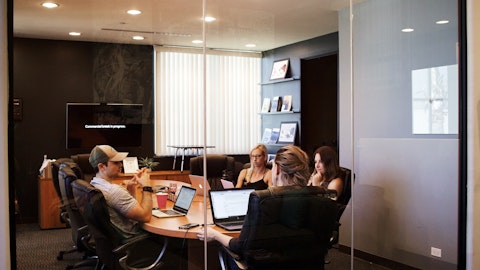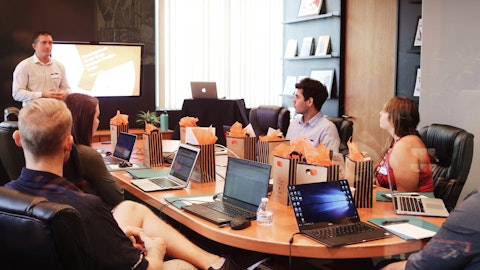Kaman Corporation (NYSE:KAMN) Q1 2023 Earnings Call Transcript May 4, 2023
Operator:
Operator: Good day and thank you for standing by. Welcome to the Kaman’s Corporation Q1 2023 Conference Call. At this time, all participants are in listen-only mode. After the speakers’ presentation, there will be a question-and-answer session. . Please be advised that today’s conference is being recorded. I would now like to hand the conference over to our speakers today. Please go ahead.
Rebecca F. Stath: Good morning. Welcome to Kaman’s First Quarter 2023 Earnings Call. Leading the call today are Ian Walsh, Chairman, President and Chief Executive Officer; and Jamie Coogan, Senior Vice President, Chief Financial Officer and Treasurer. Before we begin, please note that some of the information discussed during today’s call will consist of forward-looking statements setting forth our current expectations with respect to the future of our business, the economy and other events. These include projections of revenue, earnings and other financial items, statements on plans and objectives of the company or its management, statements of future economic performance and assumptions underlying these statements regarding the company and its business.
The company’s actual results could differ materially from those indicated in any forward-looking statements due to many factors, the most important of which are described in the company’s latest filings with the Securities and Exchange Commission, including the company’s first quarter 2023 results included on Form 10-Q and the current report on Form 8-K filed yesterday evening together with our earnings release. We also expect to discuss certain financial measures and information that are non-GAAP measures as defined in applicable SEC rules and regulations. Reconciliations to the company’s GAAP measures are included in the earnings release filed with yesterday’s 8-K. Finally, we posted an earnings call supplement on our website, which provides additional context on our financial performance.
You can find this presentation at www.kaman.com/investors/quarterlyearningscall. Now I’ll turn the call over to Ian Walsh.
Ian K. Walsh: Thank you, Becky. Good morning, everyone and thank you for joining our first quarter 2023 earnings call. We are pleased to report a solid quarter for Kaman, and we’re off to a good start for the year. Total company sales grew by 23.1% compared to the first quarter of 2022 or 11.4% organically. Our Engineered Products segment, which includes our recent acquisition of Aircraft Wheel and Brake led the way with 51.4% sales growth over the prior year. Excluding the contribution of Aircraft Wheel and Brake, this segment was up 28.6%, with gross margin nearing 40% and adjusted EBITDA margins of 23.2%. We are beginning to see the early benefits of our cost reduction efforts, and our teams are executing well as we work to reduce or eliminate the past sources of variation from our business.
Consolidated performance was further supported by growth in our Structures segment, partially offset by the anticipated decline in our Precision Products segment as our JPF program continues to wind down. As a result of stronger sales, early benefits of our cost reduction efforts and operating leverage, our first quarter operating income was $8.6 million, and adjusted EBITDA was $24.8 million, both more than doubling when compared to the prior year. In our fourth quarter report, we highlighted several strategic actions to enhance our profitability and reduce or remove sources of variation. First, we announced our intention to consolidate our JPF operations into a single facility. This will allow us to maintain operational readiness while substantially reducing our program cost as program volume winds down.
During the first quarter we began drawing down our Orlando workforce through Phase 1 of our shutdown. This consolidation effort is on plan, and the teams are working diligently to keep this on pace and within budget. There is continued interest in JPF from international customers, and we maintain a healthy level of other missile safe and arm production in Middletown, Connecticut. Second, we announced that we would discontinue producing our K-MAX aircraft. As a reminder, K-MAX units are not in our 2023 guidance and any aircraft sold during the year would represent upside, particularly on revenue and cash flow guidance. Lastly, we announced incremental cost reduction measures for our corporate function. To this end, we have assembled a team, including both internal and external resources to identify additional cost savings and margin enhancement opportunities.
In total, from all these activities, we continue to expect between $22 million and $25 million in annual savings by 2024. Turning to our end markets and outlook, all of our end markets are performing well through the first quarter, led by commercial Business and General Aviation, where we had the contributions of Aircraft Wheel and Brake acquisition and also saw significant organic sales growth to Boeing and Airbus compared to the prior year. Our defense business, we experienced the first quarter of year-over-year sales growth since 2020 as strength in our core defense portfolio more than offset the wind down of the JPF program. In our medical end market, we continued to demonstrate robust top line growth with the positive organic contributions from a medical implantable and analytical instrument product lines.
Finally, in our industrial end market, sales were largely stable with modest organic growth during the period. Turning to our segments and beginning with Engineered Products, strong performance from this segment continued in the first three months of 2023 as a function of their differentiated technologies, strong barriers to entry, and pricing power. The first quarter results, combined with the strength of our backlog gives us confidence in this segment’s operating performance for the remainder of the year. Sales for the segment grew 51.4% from the prior year, which was inclusive of an $18.5 million contribution from Aircraft Wheel and Brake. Sales growth was widespread across this portfolio, led by our self-lubricated bearings and PMA aftermarket businesses.
Higher sales also translate to solid segment level profitability as segment level operating income and adjusted EBITDA came in ahead of our internal plan at $19.4 million and $30.1 million, respectively. Backlog for Engineered Products has never been stronger. In our Precision Products segment, sales declined 20.1% to $38 million, which is almost entirely due to lower volume of our JPF program. Segment operating income and adjusted EBITDA also declined to $1.7 million and $2.5 million, respectively. Anticipated lower margin compared to the prior year resulted from lost operating leverage on lower sales coupled with higher R&D expense on new programs. We are planning for a significant portion of our cost reduction efforts to impact this segment as we are focused on building the foundation to support our new technologies and providing meaningful growth and long-term performance beginning in 2024 and beyond.
Precision Products continues to pivot to development of next-generation products such as missile actuation systems, fuses, autonomous components, and autonomous air vehicles. We are underway with our Marine Corps funded MULS-A program for our new cargo UAV and look forward to working with PHI Aviation, who has given us a nonbinding order for our first 50 commercial units. In our Structures segment, performance improved sequentially and compared to the prior year, although absolute margin levels are still below our long-term targets. Our Vermont facility continues to exceed expectations and is the benchmark for operational optimization for our other structures facilities. In total, segment level sales were up 14.5% in the prior year to $33.2 million, and the segment was near breakeven at operating income level, while adjusted EBITDA margin was 1.7%.
We continue to recover and improve the schedule, cost, and on-time delivery of our legacy programs while focusing on winning new, more profitable OEM and aftermarket work as we have demonstrated we can do. We are pleased with the progress we have demonstrated out of the gate in 2023, which reflects the positive impact of our transformational strategy, the underlying momentum in our business units, and initial success of the conscious and planned actions we took in 2022. In the near-term, we continue to focus on several primary objectives; first, to provide the necessary capital resources to maximize the strongest growth opportunities in front of us, specifically in our Engineered Products segment and to continue innovating and partnering with our customers to generate strong year-over-year organic growth and high margin and cash flow generation.
Second, we seek to transition our Precision Products segment with thoughtful and targeted investment in next-generation products. The sunset of the JPF program, followed by the associated facility reduction plans, along with the conclusion of K-MAX production, we’re specifically designed to improve our net working capital performance and reposition the segment for future of profitable growth in the remaining missiles programs, memory measurement products, and future autonomous components of unmanned cargo UAV platforms. Third, we are diligently working to implement best practices across our Structures segment and to have all three of our structures business is operating in a healthy and consistent manner with improved performance. And finally, we are working to reduce our leverage and interest expense following the important acquisition of Aircraft Wheel and Brake.
Generating strong free cash flow is our focus as delevering is a key priority in our near-term capital allocation strategy. I am proud of our team and the progress we have made in a short period of time with our employees’ dedication, resiliency and ingenuity, we are able to continue our path to achieving greater and maximizing value to our stakeholders over time. Now I’ll turn the call over to Jamie for a closer look at the numbers. Jamie?
James G. Coogan: Thank you, Ian, and good morning, everyone. Today, I will walk you through our first quarter results before turning to our outlook for 2023. First quarter sales were $194.5 million, which was up 23.1% from $158 million in the prior year. Higher sales in the quarter were attributable to organic growth of 11.4%, primarily in our Engineered Products segment and an $18.5 million contribution from the Aircraft Wheel and Brake acquisition. This was partially offset by the expected lower JPF volume where in the quarter, we recorded $15.3 million of sales for this program and have $4.8 million left in backlog as we enter the second quarter. Operating income in the first quarter was $8.6 million compared to $3.1 million in the prior year.
Adjusted EBITDA in the first quarter was $24.8 million, which more than doubled the prior year result of $12.2 million. EBITDA margin also increased 500 basis points, expanding to 12.7% from the 7.7% we recorded in the prior year as a result of operating leverage on higher sales and early benefits of our cost reduction program. We’ve moved aggressively in the first quarter to execute on our cost reduction plan. And in aggregate, we continue to expect annual savings of $22 million to $25 million by 2024, with about $12 million to be realized in 2023. In the first quarter, these cost-out programs delivered approximately $2 million of savings by category, our cost-out program is comprised of the following; $12 million to $15 million associated with the closure of the Orlando facility.
We began to see some of these savings in the first quarter as we reduced our operating activity and executed on the first phase of our shutdown plan. We expect to see a contribution of this run rate in the balance of the year with full savings achieved by the end of 2024. At least $7 million related to corporate restructuring, primarily focused on the rightsizing of our corporate structure to current sales levels and the elimination of redundant functions between corporate and the businesses. To this end, we have now assembled the team comprised of internal and external resources to streamline certain administrative functions and reduce inefficiency. And lastly, around $3 million related to discontinuing production of the K-MAX aircraft. Turning back to our results, gross margin was 34.7%, which increased 270 basis points compared to the prior year.
This was attributable to the addition of Aircraft Wheel and Brake, better performance at our K-MAX aftermarket program and execution on the cost savings initiatives we implemented last quarter. First quarter SG&A was $43.7 million or 22.5% of sales compared to $39.7 million or 25.1% of sales in the prior year. Higher dollar SG&A was related to the addition of Aircraft Wheel and Brake. As a percentage of sales, lower SG&A was related to leverage on higher volume and cost controls. Interest expense in the quarter was $9.6 million compared to $2.5 million in the prior year as a result of higher interest rates and the added debt from the Aircraft Wheel and Brake acquisition. We remain committed to delivering our balance sheet and maintaining a disciplined approach to shareholder returns.
As we have some near-term maturities on the horizon, we are in discussions with our banking partners to ensure our goals and objectives for our capital structure will continue to be met, and we will continue to support the needs for our access to capital to continue to grow the business. Free cash flow for the quarter came in ahead of our internal plan due to the timing of receipts, and we anticipate turning cash flow positive in the second half of the year. We reported a GAAP net loss of $19,000 or $0.00 per diluted share compared to $4 million or $0.14 per diluted share in the prior year. Adjusted net earnings in the first quarter was $2.3 million or $0.08 per diluted share compared to $4.3 million or $0.15 per diluted share in the prior year.
Included in the current period are adjustments for restructuring and severance and for integration and implementation activities related to the acquisition of Aircraft Wheel and Brake and initial costs associated with the setup of a new joint venture to satisfy offset requirements we have associated with a completed JPF DCS contract. For a full reconciliation of our GAAP to non-GAAP earnings, please review our earnings press release. Now turning to our outlook. We are reaffirming our full year 2023 guidance. As Ian detailed, our end markets are performing well. We continue to grow share in our Engineered Products segment. Our overall backlog is robust, and we remain focused on expanding our highest growth businesses, where we can generate stronger returns while optimizing our cost structure to match the size of our business.
As a result, we continue to target top line growth in 2023 with total revenue in the range of $730 million to $750 million. Full year adjusted EBITDA is expected to be in the range of $95 million to $105 million and operating cash flows for 2023 of $60 million to $70 million, leading to free cash flow expectations in the range of $35 million to $45 million. Approximately 35% of our adjusted EBITDA improvement is from growth in our organic business and lower expense due to the cost actions we’ve taken with the remainder coming from the addition of Aircraft Wheel and Brake. These increases are partially offset by the impact of lower JPF volume. As a reminder, to improve the reliability of our guidance and improved transparency, we have excluded discrete items which have historically been high sources of variation.
Specifically, these include unawarded or uncertain JPF DCS orders and sales of remaining K-MAX aircraft held in inventory. We have also assumed no margin contribution from our Structures segment. We expect to achieve success in these areas, but they are not incorporated in our guidance for 2023. With that, I will turn the call back over to Ian for closing remarks.
Ian K. Walsh: Thanks, Jamie. We have begun 2023 on a much stronger footing as planned. Our team remains focused and diligent to deliver on the commitments we have made. For the performance of this quarter, the earnings power and growth of Engineered Products segment is evident. And when combined with improvements in our Precision Products & Structures segment, we expect to be well positioned to substantially grow our earnings and steadily delever our balance sheet. We continue to develop a culture with greater internal discipline, controls and leadership. Our future will always be dependent on our talent, and I’m thankful to our workforce whose commitment has been instrumental in our success. With that, I’d like to open the line for questions, may we have our first question, please.
Q&A Session
Follow Kaman Corp (NYSE:KAMN)
Follow Kaman Corp (NYSE:KAMN)
Operator: Thank you. . Our first question comes from Steve Barger from KeyBanc. Your line is now open.
Steve Barger: Thanks. Good morning.
Ian K. Walsh: Good morning Steve.
Steve Barger: Can we start with the pivot for precision, you said the most significant cost reductions will be in that segment but I think you also said the segment will be the focus for developing and ramping next-generation products. Can you talk through what a bridge looks like for revenue and margin as that progresses?
Ian K. Walsh: I can talk, Steve, a little bit about what we’re certainly working on. Obviously, the different components of Precision Products include JPF winding down, therefore, the remainder of the missile infuse programs. There are some next-generation infusing that we’re working on, which is with our OEMs, which we have strong relationships with. Part of that includes our FireBurst program, which again is a function of our offset requirements, working with overseas partner, but we see a fairly large addressable market there over time. We also have our memory and measurement business, which is relatively profitable, and we’re looking to figure out how to scale that more meaningfully over time. And then obviously, if you think about Precision products, it includes KV, we’ve got our aftermarket, which is relatively stable in the KMAX side, which we continue to support.
And then the largest opportunity of all is our cargo program. And again, with the recent orders we’ve got from PHI, which is excellent partnership there, current MULS-A program and other services who are coming online, specifically the Army is very interested in solving this contest logistics problem. So that’s kind of where the bulk of the growth is going to be over time.
Steve Barger: So how should we think about the base non-JPF revenue for Precision on a quarterly basis just for modeling purposes? And will there be factors that affect seasonality there?
James G. Coogan: Yes. So as it relates to seasonality over the course of the year, we typically will see higher aftermarket for K-MAX in the back half of the year as our operators utilize the aircraft over the course of the period and sort of take the winter months to do service and other necessary maintenance and programmatics related to that. I think historically, if you sort of strip out the K-MAX sales again, last year was about $15 million or so of K-MAX aircraft sales, about $100 million or so worth of JPF sales inside of there. That gives you a better sense of on a kind of ongoing basis, what Precision products would look like, excluding sort of the ramp up and the opportunities that Ian mentioned.
Steve Barger: Yes, that’s helpful, thanks. And just updated — oh, sorry, go ahead.
Ian K. Walsh: No. Go ahead.
Steve Barger: Any updated thoughts on the timing of cargo UAV, when you’re planning that initial full-scale flight, what’s happening in terms of development and customer conversations beyond what you already talked about?
Ian K. Walsh: Yes. So for first flight, the team has been working really hard, obviously, to get to that first flight. We’ve got a — we anticipate having the first flight clearly this year. We’re on a MULS-A program schedule. So we obviously are on a time line there. The good news is that we’re spending more time working on testing all of the proper components just to give more detail. I mean it includes the entire set of everything from the power plant, the propulsion. We have structural tests. We’ve got dynamic testing. We’ve got a new world rig, we just established here on campus. So we’re getting very close to that first flight, which is — it’s going to be exciting for us and the team certainly. And we are on schedule with the MULS-A program with the Marine Corps, which again, from the schedule perspective has an award in late next year, that will then — and it could be a single award, it could be multiple award depending on the competition we’ll see.
But that’s going to lead to funded multiple variants being produced that will then be field tested. Once that field testing occurs, that probably takes another year and half or so, then they go to look to have a single award and go to lower rate and full rate production. So the Marine Corps is still trying to go as fast as they can. But technically, they’re trying to field this medium-lift capability in the 20, kind of late 2025, 2026-time frame, which also is in concert with what the commercial folks are looking to do as well. And then the commercial operators, including our PHI, we’re not waiting for them. We’re working those developments in parallel with them.
Steve Barger: Understood. So — but beyond low rate production, this is — you don’t expect or we shouldn’t expect that this is a revenue contributor until 25-ish?
Ian K. Walsh: Correct. Yes, 2025 and 226.
James G. Coogan: We’ll see some incremental kind of funded R&D as we go through the developmental process, Steve. But right as it relates to I’ll call it, commercial revenue on units, it would be 2025, 2026-time frame.
Ian K. Walsh: And what we can’t — what we don’t have real clear sight of right now, just Steve to add more color, is the Army is working very closely with the Marine Corps. Naturally, they want to piggyback as much as they can off of a medium lift development. So — and that includes SOCOM, which is another one. So those are two other opportunities that could have funding behind them in concert with what we’re doing with the Marine Corps.
Steve Barger: Got it. I’ll ask one more and get back in line. The press really said you intend to pay down debt through the remainder of the year. And Jamie, you said you expect to be free cash flow positive in the back half. Do you have a target for debt reduction this year or can you get meaningfully below the $561 million you ended last year with?
James G. Coogan: Yes. So we’re going to — again, if you look at our cash flow guide, you look at sort of where we expect dividend payments and others to be, Steve, right. It’s about $20 million or so of incremental debt pay-down just using sort of the straight math. Now we do have opportunities, and we are working diligently to overcome and improve our net working capital. Again, that was part of the announcements we made at the end of last year was specifically designed to drive improved net working capital performance for the business. We also have the opportunities to continue to market and sell K-MAX aircraft, which could provide some cash upside for the full year — so we’re working that very hard to try to get down that debt curve. It will — we will see improved, I would say, leverage, but that’s going to come from improved financial performance or stronger earnings as well as the incremental debt pay-down.
Steve Barger: Thanks.
Operator: Thank you. One moment as I prepare the next question. Our next question comes from Larry Solow from CJS Securities. Your line is now open.
Lawrence Solow: Great, thanks, and good morning everybody. Just a couple of questions on engineered products so we can start there. So obviously, really nice growth as you mentioned, close to 30% organic. Just trying to parse out the growth where it’s coming from between — it feels like it’s mostly defense, but I know you’ve spoken, obviously, increasing exposure at least to medical. So maybe you can help us sort of parse out from a high level, the market is growing in. And then also, you mentioned pricing power, and I know we’ve had some considerable inflation in the last couple of years. So just trying to — if you could help us see getting better pricing today and also part of that question, I guess, Part C, new products as some of your newer products driving some of this growth? Thanks.
Ian K. Walsh: Yes, Larry, good morning, I’ll start. The bulk of the growth is clearly coming from the commercial recovery as well as defense in certain markets and aftermarket with businesses like our XX business and even Aircraft Wheel and Brake. So that’s where we’re seeing the bulk of it. And again, a function of that is really the market share wins that we established effectively during COVID 2020 to 2021. We really did a lot of good work working with our customers to grab more content. And now as those platforms come back online, the growth rates you’re seeing single aisle for sure at Airbus and Boeing are materializing through those businesses. On the medical side, again, a lot of good progress with our medical folks such as and GRW.
Most of our businesses at the end of last year ended with record backlogs, which is really encouraging. So now it’s really a function of just executing against that growth. We had the largest backlog as the earliest we’ve ever had, meaning this year. And when it comes to pricing power for this year, we did really spend a lot of time last year focusing on all of those inbound costs, a lot of supplier changes, and things that were coming through. We actually changed a lot of our pricing procedures in terms of how frequently we’re increasing prices, looking at recurring LTAs versus one-offs that come in. And that’s actually an ongoing process. So I would tell you that we’ve got a much stronger pricing philosophy this year than we have in the years past.
Lawrence Solow: Okay. Great. That sounds encouraging. And just new products, anything — it sounds like you’re filling newer platforms. But are newer products contributing, I mean I guess you always kind of have some newer products, but anything — I know you’ve spoken to some new next-generation products, maybe titanium and stuff coming online. Maybe you can give us some kind of update on that and year-on-year for that?
Ian K. Walsh: Yes. We mentioned last time, and this is a continuing process with K-MAX and for example, TDH. We have roughly 30 applications that are either being qualified or currently being tested across a range of different applications. A lot of that is really in the space market, which is growing nicely. But we also have a lot in the medical side. And we’ve got some really nice opportunities with some of our customers. When you think about kind of things like joint arthroplasty and these are where you’re putting in devices in spines or implantable, that’s where a lot of the TTH comes into play. And that’s really a function of the fact that certain materials, the human body is allergic to, and what the medical industry is really understanding and figuring out is that titanium is not.
So that’s a real opportunity for us there. There’s other growth opportunities that we have. A lot of our OEMs when you think about platforms, whether it’s Gulfstream and folks like that, where they’re coming online with new platforms, we’ve got content there. And then even with the programs like CH-53K on the military side, a lot of good work there on content there. And we’ve had some recent meetings. As everybody is aware, it was exciting to see Bell win the flora program with the V-280. We just had a big meeting with our customer there as they’re getting ready for production readiness review in a couple of years and locking in suppliers, and we’ve got some content that we’re working on with that customer.
Lawrence Solow: Great. And just last, if I may, just on the structured business. It sounds like — I know you’re not building any improvement into formal guidance, but at least from a qualitative level, I know you had a little bit of a tailwind last year, excuse me, a headwind from some supply issues and the fire, I guess, that happened. But maybe from just on a qualitative update it feels like maybe things will advance this year, we’ll see that even a little bit of flow to the bottom line. Is that a fair assessment?
Ian K. Walsh: Yes, it is. Just so everybody understands too, last year was really it was a very isolated situation with only just two suppliers that really impacted our age 60 line, our Sikorsky cockpit line at Jacksonville. And the team has worked really hard to have a recovery schedule that’s now been built. We are in lockstep with Sikorsky on that. Our supply chain problems have been corrected. We’re now bringing in the parts the way we need to, and we’re building cockpits back to rate. It doesn’t mean that we’re out of the woods yet. We’re always working supply chain stuff, but it’s — and we’ve built these cockpits for many, many years. We’ve been a titanium supplier of Sikorsky. Our path forward is to get back to that level, and we anticipate doing that this year.
The other program was A10. And that’s a flow that goes from Wichita to Jacks , legacy program, a lot of issues with start-up there and first articles. Those have all been corrected in the past. We’ve passed our production readiness through with the customer and the Air Force. So we’ve now got parts flowing there. But again, we’re still working supplier issues as we move through it. But I think we’re on the heal there and looking for better performance from both those businesses. Comparatively, Vermont, as we’ve mentioned, has just done a magnificent job with building their capacity, building their quality, and really driving margin improvement. Certainly, gross margin improvement as a function of a lot of just basic lean practices, better tooling and tire tolerances and their parts, which really drives the gross margin overall performance there.
So they’ve done a really nice job. And we’re leveraging as much as we can from that experience in the last year and half of Vermont and bringing that into Wichita and Jack. And again, as we mentioned in the call, we’ve got internal support myself included, but also other support from the outside helping both those businesses.
Lawrence Solow: Great. I appreciate all the color. Thanks Ian.
Operator: Thank you. One moment as I prepare the next question. Our next question comes from the line of Seth Seifman from J.P. Morgan. Your line is now open.
Seth Seifman: Hey, thanks very much and good morning everyone. I just wanted to start off kind of touching on the balance sheet and you kind of mentioned that looking at the capital structure. I’m just kind of curious how you’re thinking about the time line there given the upcoming — I guess, the converts will be current on the next balance sheet and if that kind of factors into your thought process about when you want to sort of relook at some of the stuff on the balance sheet?
James G. Coogan: Yes, good question. It does. I mean we’re working with our bank team now, our bank group now, right, as we go through that process to look at the options we have in front of us. As you noted, the converts are going to kind of roll current by the end of the second quarter. We do have enough capacity today and enough available capacity underneath our credit agreement to take those converts out with the revolving credit agreement. So I think our goal would be to continue to leverage the lower coupon rate on that for a period of time. But all I can kind of say right now is that we’re sort of actively with talking to the bank group about the options we have in front of us.
Seth Seifman: Okay. Great. Thanks. And then strong results in Precision — in Engineered products this quarter, particularly on the military side. And I guess, is that level of revenue we saw in the quarter, is that a good run rate for now, and — or is there kind of — do you think about revenue kind of growing off of that $20 million run rate we saw in Q1?
James G. Coogan: Yes, I think it is a good run rate. We do — I mean, typically, we see — if you look back historically at engineered products over the course of the year, we do actually see volumes increase in that business over the course of the year. What we’ll see a lot of times are drop-in orders and other things that come in that help to benefit the period outside of what we would consider to be our normal build rate schedules. So again, strong performance in Q1 out of Engineered products. We do expect that to continue throughout the remainder of the year with the potential for upside opportunity in the back half.
Seth Seifman: Great, okay. And maybe last one just on Wheel and Brake. It seems like that’s on a pace for maybe kind of 75-ish million of sales this year. Is that a fair way to think about where that contribution might come in?
Ian K. Walsh: Yes, Seth, it’s Ian. Yes, Aircraft Wheel and Brakes is performing well. We have a high degree of confidence that they’re going to hit those numbers. And we’re working with them right now to think about other future growth opportunities inside their business with the technology they have.
Seth Seifman: Okay. Excellent, cool, thanks very much.
Ian K. Walsh: Thanks Seth.
Operator: Thank you for your question. At this time, I would now like to turn it back to Becky Stath for closing remarks.
Rebecca F. Stath: Thank you for joining us on today’s conference call. We look forward to speaking with you again when we report our second quarter results.
Operator: Thank you for your participation in today’s conference. This does conclude the program. You may now disconnect.





